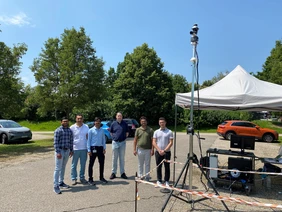The project was funded by the Bavarian State Ministry of Economic Affairs, Regional Development and Energy (StMWi) and was carried out and completed jointly by THI, Fraunhofer IVI Application Centre Ingolstadt, e.Mundo GmbH and e:fs TechHub GmbH. From the beginning of the project, each partner had a clear role to play, which helped to ensure that the research was carried out efficiently and that there were good synergies between the different technologies. For example, THI and Fraunhofer IVI developed the intelligent roadside infrastructure system with camera, radar, and lidar sensors, as well as the sensor data fusion algorithm to detect road users across the intersection in real time. Similarly, eMundo GmbH developed road user-dependent situation detection, intelligent traffic light control, and remote sensor monitoring. In addition, e:fs TechHub GmbH performed and documented a detailed analysis of the safety aspects of the entire system.
Throughout the project, numerous brainstorming sessions were held to jointly develop the concepts of the project and then regularly improve them to achieve synergy between all subsystems. Towards the end of the project, intensive integration tests (both at the software and hardware level) were carried out several times to develop the fully functional system according to the defined requirements, where on the one hand sensors detect the road users in real-time, and on the other hand, an intelligent traffic light control system uses the input of the detected users and controls the traffic lights at the pedestrian crossing to reduce the waiting time of both pedestrians and vehicles and to improve their safety.
Extensive research is carried out to develop low-level sensor fusion of an RGB camera and a 3D automotive radar sensor using deep learning to improve the detection of different road users in harsh environmental conditions where camera-based detection alone fails. The results will then be compared with high-level data fusion. Throughout the project, several research papers will be published in conferences and journals. All the research skills, hardware and software development expertise, and safety analysis gained from this project will be used in the follow-on project(s), where a similar sensor setup will be permanently deployed at the pedestrian crossing(s) in Ingolstadt and an intelligent real-time traffic light control will be developed for public use to reduce the waiting time of people at crossings and increase their safety on the road.


![[Translate to English:] Logo Akkreditierungsrat: Systemakkreditiert](/fileadmin/_processed_/2/8/csm_AR-Siegel_Systemakkreditierung_bc4ea3377d.webp)








![[Translate to English:] Logo IHK Ausbildungsbetrieb 2023](/fileadmin/_processed_/6/0/csm_IHK_Ausbildungsbetrieb_digital_2023_6850f47537.webp)


